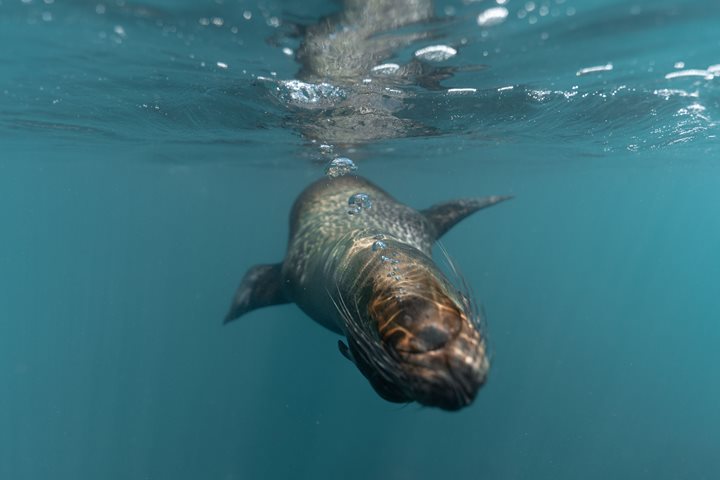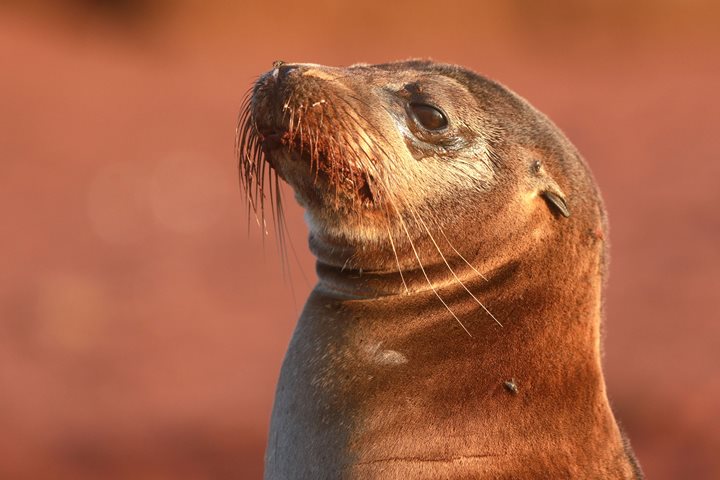Today’s expedition took place on Floreana Island. In the morning we visited Cormorant Point where there is a brackish water lagoon sometimes visited by flamingoes. This time we were very fortunate to spot five adults and two babies feeding on the lagoon, just a few meters away from us. Wildlife was up early at Cormorant Point, as we also spotted diamond rays coming to shore to warm up and flying fish being chased by Galapagos sea lions and frigate birds. We continued the expedition in the water, snorkeling around Champion Islet where we spotted, octopus, eagle rays and many fish such as parrot fish, razor surgeon fish, and giant damsel fish. Besides being rich in wildlife, Floreana is also rich in human history. This island was visited by pirates and buccaneers in the 1500s and 1700s. In the late 1700s a mail barrel was installed to allow sailors to send mail home delivered by future visiting sailors. Our guests had the opportunity to go back in time and be part of this tradition and send and collect mail from Post Office Bay to hand deliver in their hometowns. A penguin bid us farewell and a beautiful sunset accompanied us back to the National Geographic Islander. It was another amazing day in paradise!
- Daily Expedition Reports
- 02 Jan 2018
Floreana Island, 1/2/2018, National Geographic Islander
- Aboard the National Geographic Islander
- Galápagos
Gianna Haro, Naturalist
Most of Gianna´s memories seem to be dreams, made on flawless white sandy beaches with black lava rock contours and gorgeous turquoise ocean waters. Most of it happened while barefoot, in an enchanting place that some people regard as an ideal natura...
Read MoreJason Heilmann, Undersea Specialist
Growing up in northern California, Jason was surrounded by the incomparable nature of the Pacific Northwest. While attending university there, Jason met and eventually married an Ecuadorian woman who happened to be from a small group of islands off t...
Read MoreShare Report
Related Reports
11/23/2022
Read
National Geographic Islander II
Isabela and Fernandina
Our day began with the chance to point out a lot of interesting geological features as we enjoyed Zodiac tours along a massive flank of Ecuador Volcano on Punta Vicente Roca. In the afternoon, we took a sunny walk on Punta Espinoza on Fernandina Island. We spotted many iguanas, and a bunch of sea lions hanging around, too.
11/22/2022
Read
National Geographic Islander II
North Seymour & Rabida Islands
Relatively small and low compared to neighboring Santa Cruz, North Seymour is located to the north of Baltra. The island is dry with predominantly low shrubs, like prickly pear cacti. The incense trees are bare during the dry season. Seabirds like frigatebirds and blue-footed boobies nest on the island, and sea lions rest on the sand when they are not fishing. Land and marine iguanas also live here. Rabida is in the middle of the archipelago and has a striking red sand beach. We observed a small colony of sea lions of all ages resting or nursing. Behind the beach, American flamingos nest in a brackish lagoon. This island is full of contrasts and wildlife that we enjoyed observing during this day of expedition.









